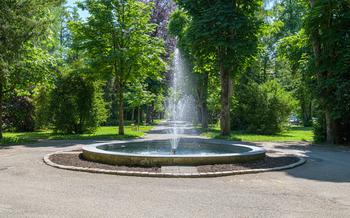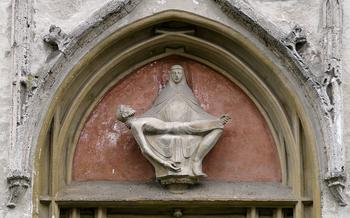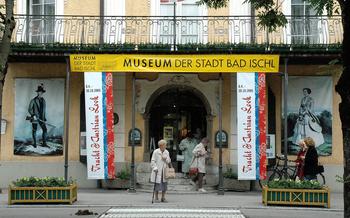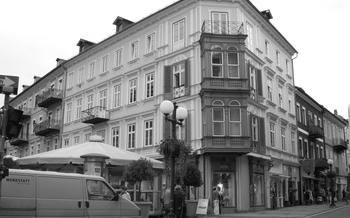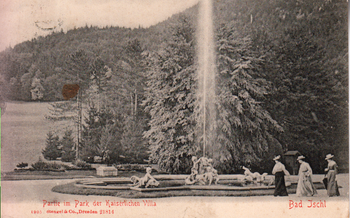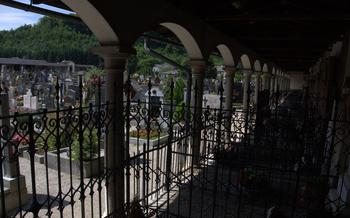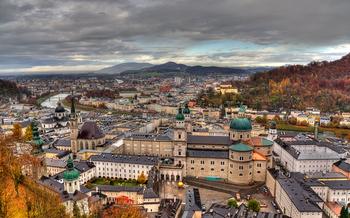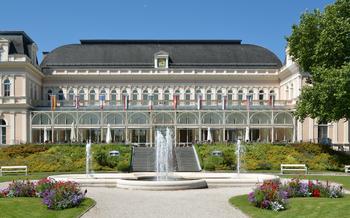
Bad Ischl Imperial Villa
- The Imperial Villa in Bad Ischl: A Historical Gem
- A Glimpse into Imperial Life
- Exploring the Villa's Lavish Interiors
- Strolling through the Picturesque Park
- The Emperor's Study: A Place of Power
- Imperial Retreat: Bad Ischl's Healing Waters
- Changing Hands: The Villa's Post-Imperial History
- The Villa Today: A Cultural and Historical Landmark
- Planning Your Visit: Essential Tips
- Capturing the Imperial Essence: Photography at the Villa
- Insider Tip: Unveiling the Villa's Secrets
The Imperial Villa in Bad Ischl: A Historical Gem
Nestled amidst the picturesque landscapes of Bad Ischl, the Imperial Villa stands as a testament to the grandeur and opulence of the Austro-Hungarian Empire. Built in 1853 as a summer residence for Emperor Franz Joseph I and Empress Elisabeth, the villa holds a significant place in Austrian history and offers a glimpse into the lives of the imperial family.
With its intricate architectural details, sprawling gardens, and lavish interiors, the villa embodies the grandeur of the Habsburg dynasty. The neoclassical facade, adorned with elegant columns and intricate carvings, reflects the architectural style popular during the 19th century. The villa's interiors showcase a blend of opulence and comfort, featuring grand ballrooms, private chambers, and intimate sitting rooms, each adorned with exquisite furniture, artwork, and decorative details.
A Glimpse into Imperial Life
Personal Stories and Anecdotes
Life within the walls of the Imperial Villa in Bad Ischl was a captivating blend of official duties, personal indulgences, and familial connections. Emperor Franz Joseph I, known for his devotion to his work, often spent his days engrossed in state affairs, meticulously reviewing documents and conducting meetings. Yet, he also found solace in the simpler pleasures of life, such as taking leisurely walks in the villa's park, indulging in his passion for hunting, and enjoying the company of his family.
Insights into Daily Routines and Rituals
The imperial family's daily routines were marked by a combination of formality and informality. Mornings began with a private breakfast, followed by a series of official engagements and meetings. Afternoons were often dedicated to outdoor activities, with the imperial couple and their children exploring the surrounding countryside or engaging in recreational pursuits such as tennis or croquet. Evenings were reserved for more formal occasions, including state dinners, receptions, and musical performances.
The Significance of Bad Ischl as a Summer Residence
Bad Ischl held a special place in the heart of the imperial family. The town's picturesque landscapes, tranquil atmosphere, and renowned thermal springs provided a welcome respite from the pressures of court life in Vienna. The imperial villa served as a sanctuary where the family could escape the formality and constraints of the capital and embrace a more relaxed and informal lifestyle.
The Role of the Villa in Imperial Decision-Making
The Imperial Villa in Bad Ischl was not merely a summer retreat; it also played a significant role in imperial decision-making. Emperor Franz Joseph I often conducted official business from the villa, receiving ministers, ambassadors, and other dignitaries. Important decisions affecting the Austro-Hungarian Empire were made within the villa's walls, shaping the course of history.
Exploring the Villa's Lavish Interiors
The Imperial Villa in Bad Ischl boasts a series of opulent rooms and chambers that showcase the grandeur and elegance of imperial life. Visitors are invited to wander through these spaces, marveling at the intricate details and exquisite furnishings that adorned the Habsburg dynasty's summer residence.
Among the villa's most impressive features is the Grand Ballroom, a vast and resplendent space designed for lavish parties and events. Its high ceilings, adorned with intricate frescoes and crystal chandeliers, create an atmosphere of opulence and grandeur. The ballroom's parquet floor, polished to perfection, reflects the shimmering light from the chandeliers, casting a warm glow throughout the room.
Another highlight of the villa's interior is the Emperor's Salon, a stately room reserved for the personal use of the emperor. This elegant chamber is furnished with luxurious armchairs and sofas, upholstered in rich fabrics and adorned with intricate carvings. The walls are adorned with portraits of Habsburg monarchs and family members, creating a sense of lineage and continuity.
The Empress's Salon, a more intimate space, reflects the personal tastes and interests of the empress. This charming room is decorated in a feminine style, with delicate floral patterns and pastel colors. The empress's personal belongings, such as her sewing table and writing desk, offer a glimpse into her daily life and hobbies.
The villa's art collection is another treasure trove, showcasing paintings, sculptures, and tapestries from various periods and styles. These works of art, carefully curated by the imperial family, reflect their refined taste and appreciation for beauty. Visitors can admire masterpieces by renowned artists, including portraits of Habsburg rulers and landscapes depicting the surrounding Salzkammergut region.
Each room of the Imperial Villa holds its own stories and legends, passed down through generations of imperial residents and staff. These tales, whispered through the centuries, add an air of mystery and intrigue to the villa's already rich history, inviting visitors to delve deeper into the lives and secrets of the Habsburg dynasty.
Strolling through the Picturesque Park
The extensive park and gardens of the Imperial Villa in Bad Ischl are a testament to the grandeur and elegance of the imperial era.
Covering an area of over 10 hectares, the park offers a serene and picturesque retreat for visitors to explore.
Highlights of the park's landscaping and design include:
-
The Emperor's Garden: Featuring meticulously manicured flower beds, fragrant rose bushes, and towering trees, this section of the park was reserved for the exclusive use of the emperor.
-
The Empress's Garden: Designed specifically for the empress, this garden showcases a variety of exotic plants, colorful blooms, and a tranquil pond.
-
The Chinese Garden: Inspired by the gardens of the Far East, this section of the park features a winding path, a graceful pavilion, and a collection of rare and beautiful plants.
The park is also adorned with exquisite sculptures and fountains, each with its own unique story to tell.
-
The Neptune Fountain: This grand fountain, located at the heart of the park, features a majestic statue of the Roman god Neptune surrounded by playful cherubs.
-
The Diana Fountain: Depicting the goddess Diana with her faithful hunting dogs, this fountain adds a touch of mythology to the park's landscape.
-
The Faun Fountain: This charming fountain features a mischievous faun playing with a dolphin, creating a lighthearted and whimsical atmosphere.
Stories and legends abound in the park, adding to its allure and mystique.
-
The Legend of the White Lady: According to local folklore, the ghost of a young woman who died of a broken heart haunts the park, searching for her lost love.
-
The Secret Grotto: Hidden among the trees, a small grotto is said to have been a favorite retreat for the emperor, where he could escape the pressures of state and enjoy moments of solitude.
-
The Wishing Tree: Visitors to the park often leave coins or notes on a designated tree, making a wish or expressing their gratitude for the beauty of the surroundings.
The Emperor's Study: A Place of Power
The emperor's study within the Imperial Villa in Bad Ischl was not merely a room; it was a sanctum of power, a place where decisions that shaped the fate of an empire were made. Here, amidst elegant furnishings and carefully curated artifacts, Emperor Franz Joseph I conducted his daily work, met with advisors, and pored over state documents.
The study was a reflection of the emperor's own meticulous nature. Order and precision reigned supreme, with each item carefully arranged to facilitate efficient work. A large desk, adorned with intricate carvings and inlaid with precious stones, dominated the room. Upon it lay maps, blueprints, and piles of papers, each awaiting the emperor's attention.
The walls were lined with floor-to-ceiling bookshelves, housing an impressive collection of volumes on history, politics, and military strategy. These books were not merely for show; the emperor was an avid reader, and he often sought solace and inspiration within the pages of his favorite authors.
An ornate chandelier hung from the ceiling, casting a warm glow upon the study's polished wood floors and rich tapestries. The air was often thick with the scent of tobacco, as the emperor indulged in his favorite pastime of smoking cigars while contemplating matters of state.
Within the confines of this study, the emperor made decisions that would have far-reaching consequences. He signed treaties, declared wars, and appointed ministers. His every word carried weight, and his every decision had the potential to alter the course of history.
The emperor's study was more than just a physical space; it was a symbol of his authority and the immense responsibility he bore as the leader of a vast and powerful empire.
Imperial Retreat: Bad Ischl's Healing Waters
Bad Ischl's fame as a spa town was a major factor in the imperial family's decision to make the town their summer residence. The town's thermal springs and spa facilities were renowned for their therapeutic benefits, and the imperial family often sought relief from their ailments in the healing waters.
Emperor Franz Josef I, in particular, suffered from rheumatism and other health issues, and he found great solace in the thermal baths. He would often spend hours soaking in the mineral-rich waters, seeking relief from his chronic pain.
Empress Elisabeth, on the other hand, was drawn to Bad Ischl's spa facilities for their beauty and tranquility. She enjoyed swimming in the thermal pools and taking leisurely walks in the spa gardens. The Empress also believed that the spa's waters had a rejuvenating effect on her skin, and she would often indulge in long spa treatments and massages.
The imperial family's patronage of Bad Ischl's spas not only boosted the town's reputation as a health resort but also contributed to the development of spa culture in the region. The imperial court's presence attracted wealthy and influential visitors from all over Europe, who flocked to Bad Ischl to experience the same healing and rejuvenating benefits as the imperial family.
Changing Hands: The Villa's Post-Imperial History
With the fall of the Austro-Hungarian Empire in 1918, the Imperial Villa in Bad Ischl faced an uncertain future. The Habsburg family was forced to relinquish ownership of the villa, and it was briefly used as a hospital during World War I. In the years that followed, the villa underwent several changes in ownership and use, including a stint as a hotel and a boarding school.
During World War II, the villa was occupied by the Nazis and used as a military hospital. After the war, it was returned to the Austrian government and underwent a period of restoration. In 1957, the villa was opened to the public as a museum, and it has since become one of the most popular tourist attractions in Bad Ischl.
Despite its many changes in fortune, the Imperial Villa has managed to retain its original charm and grandeur. Today, it stands as a testament to the Habsburg dynasty and the rich history of Bad Ischl.
The Villa Today: A Cultural and Historical Landmark
Today, the Imperial Villa in Bad Ischl stands as a testament to the grandeur of the Habsburg era. Lovingly restored and preserved, it has been transformed into a museum and cultural center that invites visitors to step back in time and experience the imperial lifestyle.
The villa's opulent interiors have been carefully maintained, showcasing the exquisite furniture, artwork, and décor that once adorned the imperial family's private chambers. Visitors can wander through the grand rooms, marveling at the intricate details and imagining the lavish parties and events that once took place within these walls.
In addition to its historical significance, the villa now serves as a vibrant cultural hub. It hosts a variety of exhibitions, concerts, and educational programs throughout the year, offering visitors the chance to delve deeper into the history and culture of the imperial era.
The villa's transformation into a cultural landmark has not only preserved its legacy but has also made it accessible to a wider audience. It now stands as a symbol of Bad Ischl's rich imperial heritage, inviting visitors to explore the fascinating stories and secrets that lie within its walls.
Planning Your Visit: Essential Tips
To make the most of your visit to the Bad Ischl Imperial Villa, here are some essential tips to keep in mind:
-
Opening Hours: The villa is open to the public from 9 am to 5 pm, seven days a week, except on certain holidays. Check the official website for the most up-to-date information on opening hours.
-
Admission Fees: The standard admission fee for adults is 15 euros, while children under 15 years old can enter for free. Discounted rates are available for students, seniors, and groups.
-
Guided Tours: Guided tours of the villa are available in English and German and are highly recommended for a deeper understanding of its history and significance. Tours typically last around 60 to 90 minutes and can be booked in advance or on the spot.
-
Getting There: The villa is conveniently located in the heart of Bad Ischl, a short walk from the town center. It is easily accessible by public transportation, with several bus lines stopping nearby. If you're driving, there is ample parking available in the surrounding area.
-
Combining Attractions: A visit to the Imperial Villa can be easily combined with other attractions in Bad Ischl. The town is home to several museums, historical landmarks, and beautiful parks, making it an ideal destination for a day trip or a longer stay.
-
Insider Tip: For a truly immersive experience, consider visiting the villa during one of its special events or exhibitions. These events often offer unique insights into the villa's history and provide a chance to see it decorated in its full imperial splendor.
Capturing the Imperial Essence: Photography at the Villa
The Imperial Villa in Bad Ischl offers a treasure trove of photographic opportunities for visitors who wish to capture the essence of its imperial past. With its grand architecture, lavish interiors, and picturesque park, the villa provides a stunning backdrop for photography enthusiasts.
Tips for Taking Photos Inside the Villa and Its Grounds
- Use a wide-angle lens to capture the grandeur of the villa's rooms and the expansive views from its windows.
- Take advantage of the natural light streaming through the windows to create soft and diffused lighting.
- Experiment with different angles and perspectives to capture unique and creative shots.
- Look for details such as intricate carvings, antique furniture, and artwork to add depth and interest to your photos.
Tips for Capturing the Best Angles and Lighting
- Visit the villa during the golden hours of sunrise or sunset to capture the most flattering light.
- Position yourself in front of windows to take advantage of the natural light and create beautiful silhouettes.
- Use a tripod to stabilize your camera and avoid blurry photos.
- Adjust your camera settings to achieve the desired exposure and focus.
Suggestions for Creating Unique and Memorable Photo Compositions
- Incorporate people into your photos to add a sense of scale and human interest.
- Use leading lines such as pathways, staircases, or columns to draw the viewer's eye into the image.
- Create depth by including foreground, midground, and background elements.
- Experiment with different shutter speeds to capture motion blur or freeze movement.
Insider Tips for Using Photography to Tell a Story About the Villa
- Research the history of the villa and the imperial family to understand the context of your photos.
- Capture details that tell a story, such as personal belongings, family portraits, or historical documents.
- Arrange your photos in a sequence to create a visual narrative that takes the viewer on a journey through the villa's history.
- Use photo editing software to enhance your photos and add creative effects.
Insider Tip: Unveiling the Villa's Secrets
Beyond the grand halls and manicured gardens, the Bad Ischl Imperial Villa holds a treasure trove of hidden secrets waiting to be unveiled. For a truly immersive experience, inquire about special events and exhibitions that delve deeper into the villa's rich history. These events often feature guest speakers, historical reenactments, and exclusive access to restricted areas of the villa.
To uncover the lesser-known stories of the imperial family, seek out guided tours that venture beyond the main attractions. These tours may take you through secret passages, hidden rooms, and forgotten corners of the villa, revealing the personal lives and intrigues of its former occupants.
Don't limit your exploration to the villa itself. The surrounding area of Bad Ischl is steeped in imperial history, with landmarks like the Kaiservilla and the Trinkhalle waiting to be discovered. Take a leisurely stroll through the town, following in the footsteps of emperors and empresses as you uncover their favorite haunts and hidden gems.
To truly immerse yourself in the imperial experience, consider extending your stay in Bad Ischl. The town offers a range of charming hotels, guesthouses, and restaurants that evoke the elegance and grandeur of a bygone era. Embrace the imperial lifestyle with horse-drawn carriage rides, thermal spa treatments, and gourmet feasts fit for royalty.
With a little curiosity and exploration, you'll uncover the hidden treasures of the Bad Ischl Imperial Villa and gain a deeper appreciation for its fascinating history. Let the villa's secrets transport you back in time, offering a glimpse into the lives of the Habsburg dynasty and the grandeur of the Austro-Hungarian Empire.
